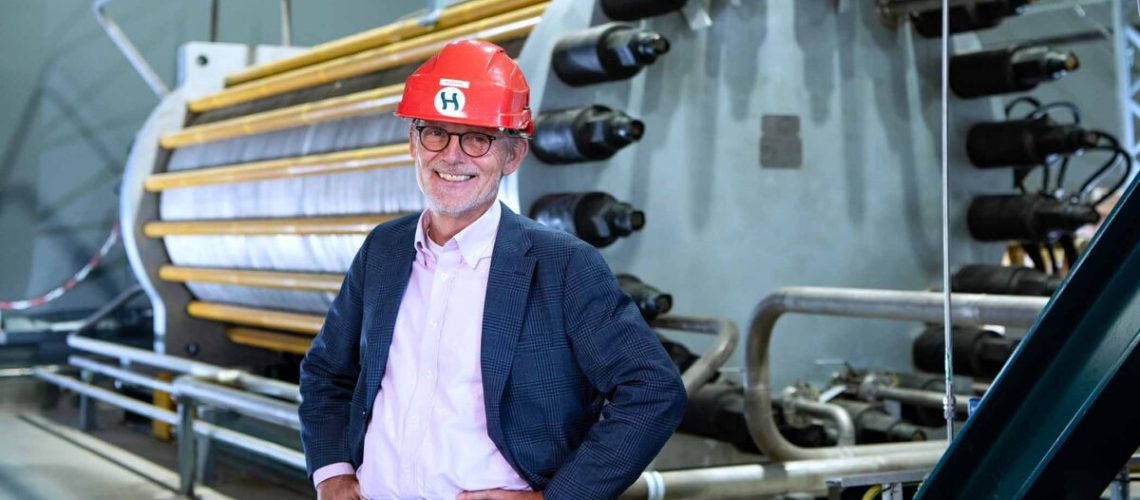Production of “green hydrogen” using renewables economically is a key focus.
With hydrogen increasingly eyed as a promising alternative fuel for the transportation and energy sectors, vastly more hydrogen will be needed and processes for producing it cleanly will become more important.
Methods for producing hydrogen are color coded for how free they are from greenhouse emissions, with green hydrogen being the cleanest. In this context, “green” hydrogen specifically means gas produced by electrolysis that is powered by renewable energy, such as wind and solar.
Norway-based HydrogenPro, a manufacturer of electrolyzer systems for green hydrogen production, recently signed an agreement with Germany’s J. Heinr. Kramer Group, an industrial engineering and construction firm, to develop projects in Germany, Austria and the Benelux countries focused on 5 to 50 MW scale facilities. A 10 MW electrolyzer can be expected to produce about 4.8 metric tons of hydrogen per day, which is enough to refuel the hydrogen fuel calls of more than 100 trucks.
In its Q3 earnings report, HydrogenPro said it received EUR 16.5 million from the EU Innovation Fund to support plans for the future H2-GIGA large-scale production facility focused on new electrolysis technology. This is on top of a EUR 4.7 million grant from the Export and Investment Fund of Denmark to help finance the project.
According to New York-based hydrogen startup Ecolectro, the global green hydrogen market was valued at $7 billion in 2023 and projects it will grow 41.6% annually over the next ten years. The relatively modest market reflects current demand as well as the cost and scalability of the electrolysis method. Ecolectro is striving to spur demand for green hydrogen by bringing down costs and increasing output.
The company, founded on chemistry research spinning out of Cornell University, is focused on developing an alternative to existing electrolysis technologies that use rare metals and toxic materials.
The process of electrolysis starts with water and separates it into hydrogen and oxygen gas through the introduction of electricity with a membrane to keep the gases apart. Existing systems rely on membranes that incorporate expensive iridium as well as perfluoroalkyl and polyfluoroalkyl substances, which the U.S. Environmental Protection Agency says are persistent chemicals that may be may be linked to harmful health effects in humans and animals.
Ecolectro says its proprietary anion exchange membrane (AEM) technology uses readily available materials that are both recyclable and more environmentally friendly. According to the company, its technology results in an 78% cost reduction compared to existing electrolysis systems. In addition, its AEM electrolyzers provide reliable performance with variable energy inputs from solar, wind and other intermittent renewable energy sources, which is a requirement for green hydrogen production.
This past summer, Ecolectro launched its first commercial pilot program with Liberty New York Gas, deploying a 10 kW electrolyzer to produce hydrogen that was blended with natural gas to heat commercial buildings. The company says each kilogram of hydrogen abating at least 5.5 kg of CO2 emissions that would have been produced if natural gas were used exclusively.
Liberty was able to produce green hydrogen for under $2.50/kg, which is below the U.S. Department of Energy’s 2030 target of $3/kg. Based on this performance, Ecolectro says Liberty is making plans to increase the scale of the pilot deployment to 1 MW.
Earlier this month, Ecolectro received $10.5 million in a round of funding led by Toyota Ventures. This increases total capital raised to $27.7 million, including grant funding from the U.S. Department of Energy (DOE), the National Science Foundation and the New York State’s Energy Research and Development Authority. The company says it will use the investment to produce prototype commercial 250kW to 500 kW and 1 MW to 5 MW electrolyzers in containerized systems that will be deployed with industry partners next year.
The ability to co-locate hydrogen production systems with the user of that hydrogen is considered essential because costs increase dramatically when the gas has to be compressed and transported. Working out how to integrate hydrogen production into usage applications is particularly important for potentially high-volume consumers, such as the transportation sector.
The DOE has awarded a team led by the Drive Clean Colorado, a clean transportation nonprofit, $946,000 to study hydrogen fuel-cell powered truck fleet operations. The project includes hydrogen-powered vehicle developer Qualtron and hydrogen producer and refueling station developer New Day Hydrogen.
In late October, Avina Clean Hydrogen broke ground on a facility near Long Beach, California, that will produce green hydrogen refuel trucks running on fuel cells serving the port. The facility is expected to handle up to 100 heavy trucks per day.



